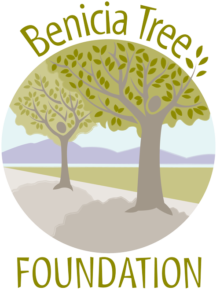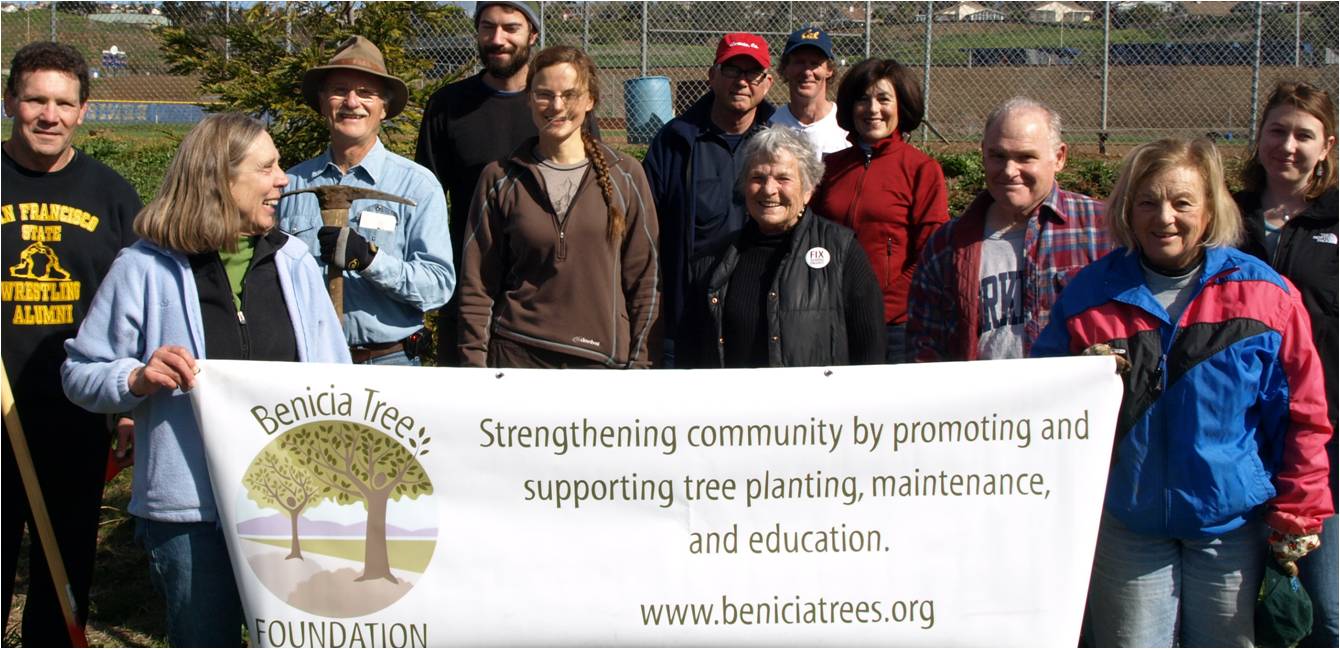Why plant trees on school campuses?
There is a growing body of local, national, and international research showing that the lack of access to healthy, natural environments is associated with childhood asthma, obesity, and diabetes. “Nature Deficit Syndrome” is a term used to describe the fact that children are spending less time outdoors, resulting in a wide range of behavioral and health problems. Healthy school environments with adequate open space and trees are considered significant factors for improving student mental health, reducing stress, and a strengthening a sense of place and community. Outdoor activities at schools, such as tree planting projects, have been shown to increase cognitive and creative capacities among students, improve scholastic achievement, and create better centers for learning and recreation. Each day, more and more tree related curriculum is available.
Benicia has recorded the fourth highest ozone levels in the Bay Area. Health data indicates that Solano County has the highest rate of asthma in the state (14.1% prevalence). A number of schools in Benicia are located near the 780 Freeway which is trafficked by 58,000 cars per day. Benicia is also centered in a cluster of several large oil refineries that produce more than 10% of California’s gasoline. Student’s health merits special attention and are among a high risk group known as “sensitive receptors” when considering the environment in which they much of their time.
The Benicia Campus Forestry Initiative Seeks to:
- Encourage Youth to Spend Time Outdoors. Through tree planting projects we seek to ensure that schoolyards in Benicia have ample trees. We seek to improve schoolyard environments with safe, accessible, and inviting tree landscapes that have positive impacts on students and provide hands on learning opportunities.
- Create Healthier Environments. By enhancing vibrant and green forested spaces for passive and active recreation, we create safer environments that contribute to improved health and well-being for the whole community that accesses school campuses.
- Promote Community Building. School tree-planting projects are a great way to involve the community and develop civic leadership skills among students. Through our tree-planting projects and education programs at the schools, we will create and build community cohesion by bringing diverse people together to work towards a common goal.
(A presentation was made to the Benicia Unified School District Board on April 19, 2012. Scroll to the bottom of the page to download this presentation for a detailed review of progress of the Campus Forestry Partnership in Benicia.)
Tree planting projects have been organized at the following Benicia school campuses:
Benicia High School
1101 Military West, Benicia, CA 94510
Liberty High School
351 East J Street, Benicia, CA 94510
Benicia Middle School
1100 Southampton Rd, Benicia, CA 94510
Joe Henderson Elementary
650 Hastings Dr, Benicia, CA 94510
Matthew Turner Elementary
540 Rose Dr, Benicia, CA 94510
Robert Semple Elementary
2015 East Third, Benicia, CA 94510
Mary Farmar Elementary
901 Military West, Benicia, CA 94510
Support Benicia Tree Foundation’s efforts to make Benicia’s school campuses healthier, cooler, and more beautiful.
Our initiative to plant 1,000 new trees in Benicia includes planting on school campuses. We present exceptional opportunities for parents, students, and community volunteers to act on concerns for the environment and public health. It is the goal of the Benicia Tree foundation to maximize your sponsorship experience– Please contact the Benicia Tree Foundation staff if you wish to discuss the benefits and opportunities associated with our School Forestry Initiative and becoming a Benicia Tree-Keeper.
Pilot Project at Benicia High School
A planting project at Benicia High School (BHS) launched the School Forestry Initiative, a partnership that includes the Benicia Tree Foundation (BTF) and the Benicia Unified School District (BUSD), among other local organizations and businesses. Principle goals are the planting of 80 trees on the Benicia High School (BHS) campus and establishing a school forestry initiative in Benicia. The project establishes the basis for regenerating the tree canopy in the BUSD, addressing key health and environmental issues impacting students and faculty.
Thanks to funding from California Releaf and from the Valero Good Neighbors / Valero Improvement Project (VIP) Settlement, eighty trees will be planted in front of the BHS athletic fields, completing a windrow that will protect one third of the campus. A shade study and other educational activities will be conducted prior, during, and after tree planting activities, demonstrating how trees improve the campus environment. The plantings will utilize sustainable landscaping and arboriculture practices recommended by BTF’s consulting arborist. The planting area will be mulched, suppressing weeds, improving soil, and reducing stormwater runoff.
The project will improve the aesthetics, health, and environment on the BHS campus, fulfilling key goals in the City of Benicia Climate Action Plan. Outcomes will include the following:
- Establishment of the first school campus forestry program in Benicia to reverse the BUSD trend of tree loss, leveraging the capacity needed for re-foresting school campuses.
- Creation of a campus grove that will provide a living science laboratory for hands-on curriculum including urban forestry, water conservation, and sustainable landscape design.
- Demonstration of positive environmental impacts including added shade and wind-break, mitigation of traffic noise and air pollution, improved soil conditions, and reduced erosion.
- The proposed plantings will address human environmental and health issues and add wildlife habitat for insects, small animals, and bird populations.
The BHS campus was established on 47 acres in 1892. Age, disease, and other factors are causing the tree population to dwindle throughout the Benicia BUSD. The campus is surrounded by asphalt surfaced parking areas, and barren hills, sparsely planted with trees. The athletic fields, lacking any buffer from the wind, or shade from the sun, require excessive irrigation, and subject sports events participants to extremes of full-sun heat or bone-chilling wind.
Community support includes the City of Benicia, local organizations and businesses, Native Plant Society (Willis Jepson Chapter), and BHS Eco and Garden clubs. BHS started a Green Academy in Fall 2011. Benicia’s Climate Action Plan is at the forefront of efforts in Solano County to make communities more sustainable. Benicia was designated a “Tree City USA” in 2009, thanks to efforts of the City of Benicia and the Rotary Club. These partnerships will flourish as tree planting projects build off of the momentum created by these community-wide efforts.
Trees will be planted according to the minimum specification guidelines for container grown trees issued by the California Department of Forestry & Fire Protection. Trees will be double-staked and tied according to the UFEI standard.
Thank you to Ed Brennan, our source of technical expertise! (Ed Brennan, ISA Certified Arborist. Certified Arborist #WE-0105A)
REFERENCES
Curriculum about trees: [Brian Note: UPDATE URL http://www.beniciatrees.org/programs/curriculum-featuring-trees]
View Benicia Unified School District in a larger map
Sensitive Receptors: Sensitive receptors refer to those segments of the population most susceptible to poor air quality (i.e. children, elderly and the sick) and to certain at-risk sensitive land uses such as schools, hospitals, parks, or residential communities. Government policies exist to reduce the negative impacts of poor air quality on sensitive receptors.
City of Benicia General Plan / Section 4. Community Health and Safety
GOAL 4.8: Protect sensitive receptors (e.g. children) from hazards.
Program 4.8.A: Identify sensitive receptors in the community and develop methods of protection.
Program 4.8.B: Establish guidelines to separate sensitive receptors from those who carry, use, process, store or generate hazardous material, including ordnance.
POLICY 4.8.1: Evaluate potential hazards and environmental risks to sensitive receptors before approving development.
Ozone in Benicia
According to a report from the Bay Area Air Quality Management District, Benicia – at a high of 75 parts per billion – was the fourth worst ozone offender in the Bay Area, right behind Bethel Island, Livermore and Concord.
The 2008 ranking was based on yearly averages from 23 Bay Area monitoring stations. The health effects of ozone exposure include respiratory damage and heightened sensitivity to allergens.
Trees and Children
“In laboratory research, visual exposure to settings with trees has produced significant recovery from stress within five minutes, as indicated by changes in blood pressure and muscle tension.” Dr. Roger S. Ulrich, Texas A&M University.
Symptoms of Attention Deficit Hyperactivity Disorder (ADHD) in children are relieved after contact with nature. Specifically, ADHD kids are better able to concentrate, complete tasks, and follow directions after playing in natural settings. The greener the setting, the more relief. Taylor, A.F.; Kuo, F.; Sullivan,W. 2001. Coping with ADD: The Surprising Connection to Green Play Settings. Environment and Behavior 33(1).
Trees help girls succeed. On average, the greener a girl’s view from home, the better she concentrates and the better her self-discipline, enabling her to make more thoughtful choices and do better in school. Taylor, Andrea Faber; Kuo, Frances E.; Sullivan, William C. 2002. Views of Nature and Self-Discipline: Evidence from Inner City Children. Journal of Environmental Psychology 22(1-2).
U.S. children and teens spend more time on academics by Diane Swanbrow, The University Record Online, The University of Michigan.
A series of studies done by the University of Illinois’ Human-Environment Research Laboratory has found that trees provide a number of direct benefits to children. The studies add to a growing body of research that shows that, in addition to being aesthetically pleasing and environmentally essential, trees have a significant impact on the physical well-being and mental health of their human neighbors.
[Brian note: link to new PDF location] – Campus Forestry Partnership Presentation BTF FINAL (2).pdf [

